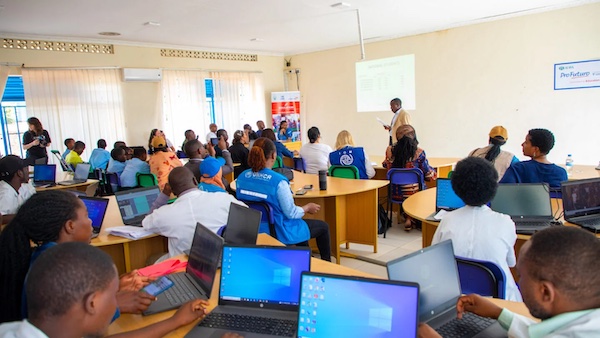
UN Heads of Agencies receive a briefing from Muhanano Jackson, the head teacher at the Paysannat L C in the recently constructed IT room alongside teachers and students
By Lilly Carlisle*
Paysannat L is the biggest school in Rwanda. Over 20,000 children from both the nearby Mahama refugee camp and Rwandan host community walk through the doors of its five different campuses every morning and afternoon.
Managing such a large proportion of students is no easy task. And although the school is fully integrated within the Rwandan national education system, UN agencies are on hand to support the educational needs of all.
Since 2021, UNHCR through funding from ProFuturo has built an IT room at the school and established a connected learning program with tablets, projectors, and other digital equipment. In partnership with WFP, children in early childhood development programmes and primary school are also provided with hot school meals. UNICEF, through its collaboration with Inspire Educate and Empower Rwanda (IEE) and the Ministry of Education, supplied 366 teachers at the school with laptops. IOM has also supported the construction of classrooms at the school.
Muhanano Jackson, the head teacher at the Paysannat L C campus states that this support is highly welcomed. During a visit of heads of UN Agencies to the school and Mahama camp, he explained that “Many of our classrooms are overcrowded. The children here are eager to learn but there remain big challenges.”
Despite the challenges, it is evident that the additional support provided by the UN is yielding positive results.
At the IT room, students scroll through lessons on individual tablets which provide a more personalized and interactive learning experience than traditional teaching methods.
Eric, a Rwandan national and physics teacher, has been teaching at the school for the last two years, and says that the connected learning curriculum has proved especially useful for teaching science subjects. “As we don’t have a laboratory here, we use the IT tools to do simulations of experiments and results which we would otherwise not be able to showcase to the students.”
Originally from the Eastern Province of Rwanda, Eric adds that he was initially nervous about teaching at such a big school far from where he grew up.
“I wasn’t sure what to expect when I got assigned a job here. On my first day I was nervous about teaching both Rwandans and refugees from Burundi and Congo in the same classroom. But the reality is there is no difference. As a teacher, I am to create harmony and a conducive environment for all students. To help them learn and have better lives,” he explains.
On the other side of the school from the IT rooms, is another innovation which supports girl students in particular. The so-called ‘girls room’ provides a safe space for female students to rest and get sanitary products when they are on their period. Salome, the teacher who runs the room on a day-to-day basis, says its impact has been transformative.
“Here we provide support for girls while they are on their period. There are spaces to lie down and rest if they need. But we also teach girls about reproductive health and female development. We have a curriculum which has been developed through the Ministry of Education and the Rwandan Biomedical Centre.”
Salome also explains that since the ‘Girls Room’ opened, there has been a notable decrease in the number of teenage girls dropping out of school. She would like to see the initiative expand to the other four campuses of Paysannat L school but for the time being, there is only the one room for all students.
From the ‘Girls Room’ to the smart classrooms, slowly but surely learning outcomes at Paysannat L school are improving. Headteacher Jackson adds that in previous end-of-year exams, some of their students were among the top-ranked in the country, marking important progress towards achieving SDG Goal 4. (End)
